Marketing spending and effectiveness are notoriously difficult to gauge—but companies are making it even harder, a McKinsey survey suggests. This survey asked chief marketing officers and other senior executives from around the world to describe how their companies assess their marketing campaigns, make their budgets, and plan new campaigns, as well as how their plans have changed as a result of the economic crisis.1
Many companies, the survey shows, don’t use basic best practices such as clearly allocating—or even defining—marketing spending across the whole company or regularly reviewing the results.2 Further, companies typically allocate their marketing budgets based on historical allocation levels and product-level priorities, rather than campaign effectiveness or the goals of the company as a whole.
The survey results begin to quantify another bit of common wisdom: that consumer-focused companies are stronger marketers. Indeed, the results show that these types of companies are much likelier to use most of the best practices. Further, though reaction to the economic downturn is varied, consumer-focused companies are more likely than others to be planning to increase their marketing spending. And regardless of where they focus, companies that use best practices—such as ensuring that marketing spending is clearly allocated and well understood across the whole company—are also likelier than others to have plans to increase their spending.
Few best practices
Across most corporate functions, performance improves when companies use detailed spending metrics to compare spending both historically and with that of competitors. But such best practices have long been famously scarce in the way companies plan, manage, and budget their marketing spending; this survey shows the surprising extent to which that is still the case.
Companies that market mainly to consumers—as opposed to business customers—are much likelier to use each of the best practices the survey asked about.3 For example, they are much likelier to have a holistic understanding of their marketing spending company-wide (Exhibit 1) and are more than twice as likely to review that spending systematically with a wide-ranging set of analytical tools (Exhibit 2). Thirty-two percent of all respondents say their companies do not compare their marketing spending with any benchmarks, and only 18 percent use any detailed benchmarks beyond marketing spending as a percent of revenue. Nearly half of consumer-focused companies, however, use detailed benchmarks.
Budget allocation
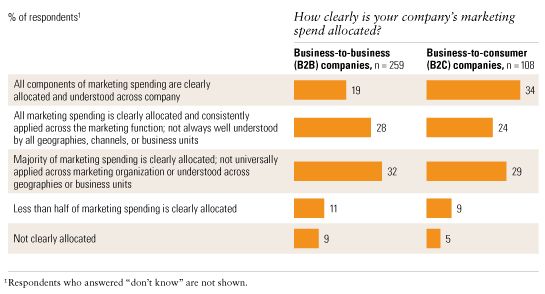
Spending process
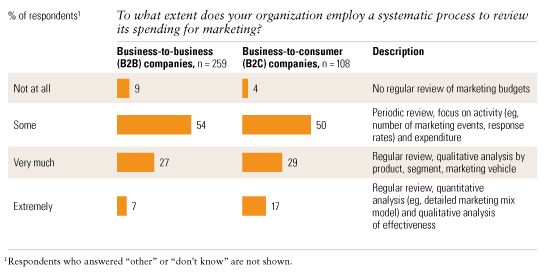
Further, though most marketing organizations track the most obvious kinds of spending, such as spending on personnel, far fewer track spending when it is funneled through channel partners or third parties (Exhibit 3).
Money management
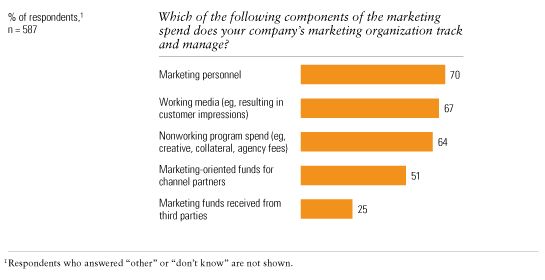
Finally, in terms of specific best practices, it’s rare for companies to use incentive-based structures to pay marketing staff or vendors; two-thirds of respondents say their companies have a very weak link or no link between marketing performance and financial incentives. Here, executives at consumer-focused companies are almost as likely to say the same when the links are weak, but a difference does exist at the very top: 15 percent of executives at consumer-focused companies say there are strong links between company-wide marketing performance and remuneration, nearly double the overall figure.
More broadly, the results show that companies overall tend to allocate spending based on historical allocations and rules of thumb far more than quantitative measures. Only a small proportion of companies use anything more complex than basic quantitative techniques (Exhibit 4). Similarly, respondents say their companies tend to use both the overall results of past campaigns and the effectiveness of specific past allocations fairly informally: just over a third say past effectiveness directly affects future allocations, and only 15 percent include overall campaign results in a clear quantitative model used to predict future results. This holds true even at the level of individual marketing vehicles.4 Between two-fifths and three-quarters of respondents say that to optimize spending on each vehicle, they use either their own historical allocation or expert opinions that don’t include any quantitative analysis.
Little use of quantitative methods
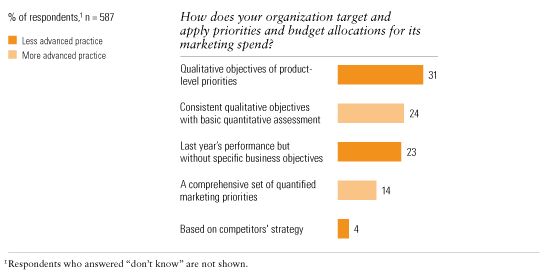
Marketing in a crisis
Nearly three-quarters of all companies are cutting operating costs in response to the global economic turmoil, according to a McKinsey survey in the field at the end of January 2009, overlapping with this one.5 Marketing, this survey indicates, isn’t as hard hit: only 45 percent of respondents to this survey say their companies will decrease their marketing spending in the next twelve months, while 20 percent expect an increase (Exhibit 5). Executives at consumer-focused companies are far more likely to say their companies will increase their spending than executives at companies focused on selling to other businesses.
Among the companies that plan to decrease their marketing spending, 40 percent are making across-the-board cuts (Exhibit 6). Comparing all responses with those at companies where marketing spending is clearly allocated and understood across the company highlights that companies in the latter group make cuts that are more targeted—and almost certainly more effective.6
Widespread cuts to marketing budgets
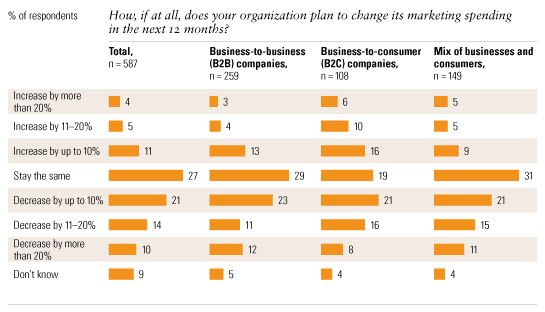
Cutting marketing spend
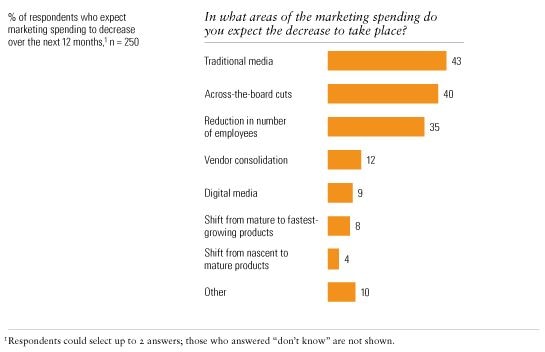
On the positive side, among companies that are increasing spending, 52 percent are spending more on their high-priority campaigns (Exhibit 7). Those with a clearer understanding of their spending also are likelier to have room in their budgets for experiments.
Additional funding
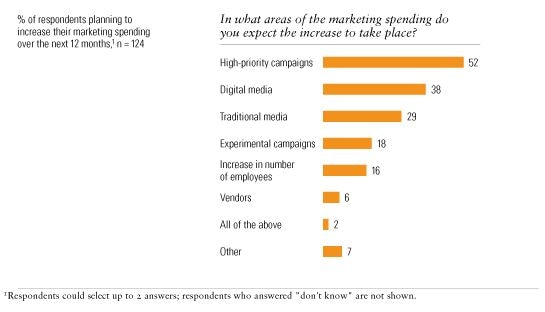
Looking ahead
-
Companies that market primarily to other businesses have an opportunity to improve their performance simply by catching up to what their consumer-oriented peers are already doing to manage their marketing programs.
-
As companies weather the economic downturn, those that better understand their spending across the company are likelier than others to make targeted spending cuts—which are more effective than across-the-board cuts—and to plan to increase spending on both high-priority campaigns and experimental ones.